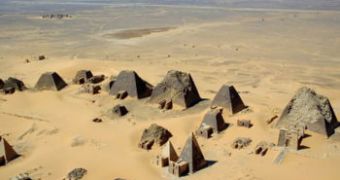Ancient people said that Egypt was a gift of the Nile. But besides the richness of life, the Nile River came with the richness that human kind has always been greedy for: gold. Archaeologists have found evidence of large-scale gold extraction in the ancient Nubian kingdom of Kush, placed along the Nile.
The finding is part of a race aimed at saving as many antiquities as possible before a dam would flood about 2,500 ancient archaeological sites. The existence of gold in Nubia "may have been one of the main reasons for the colonization of Sudan by the ancient Egyptians," said Salah Mohammed Ahmed, the head of Sudan's antiquities agency. Ancient Nubia was located along the Nile, from southern Egypt deep into what is now Sudan, and was frequently the subject of military incursions of the ancient Egyptians coming from the north.
Archaeologists from the University of Chicago discovered over 55 grinding stones at Hosh el-Geruf, about 225 mi (362 km) north of the Sudan's capital, Khartoum. "Dated to between 2000 and 1500 B.C., the stones were used to grind ore. Nubia was renowned for its gold deposits," said lead-researcher Geoff Emberling.
The ground ore was washed with water to tease out gold flakes. After Egypt's New Kingdom Pharaohs (1539 to 1075 B.C.) conquered the Kush kingdom, "they took in tribute hundreds, if not thousands, of pounds of gold each year."
Kush was the first recorded kingdom in sub-Saharan Africa, and one of the first Nile civilizations. Cushitic languages are named today after the Kush kingdom, even if Cushitic languages (Somali is the best known) are rather related to Arabic, ancient Egyptian, or Hebrew, while the Nubian languages are from the Nilotic linguistic group (like Maasai or Samburu from Eastern Africa). "Kush was unusual in that it was able to use the tools of power-military and governance-without having a system of writing, an extensive bureaucracy, or numerous urban centers," said Emberling.
The Merowe Dam will flood in the fall of 2008 about108-mi (174-km) along the Nile, on the area of the Fourth Cataract. But the local tribe of the Manasir is fiercely refusing to be displaced and some Manasir leaders blame the archaeologists for offering political cover for the dam construction, and they have forbidden salvage efforts in their territory. Arriving in Sudan, in January, Emberling's team faced Manasir's refusal to allow them to dig near their territory.
The American team was then invited by a Polish team to work at one of their sites, just outside Manasir territory. The team found in a cemetery, at a nearby site called Al-Widay, jars and tulip-shaped beakers from the Kushite capital of Kerma. "The Kerma artifacts suggest that Kushite leaders were able to project their control more than a hundred miles (160 kilometers) farther up the Nile than previously thought," Ahmed said.
Archaeologists were able to explore just a fraction of the 2,500 sites in the area before the flood.

 14 DAY TRIAL //
14 DAY TRIAL //